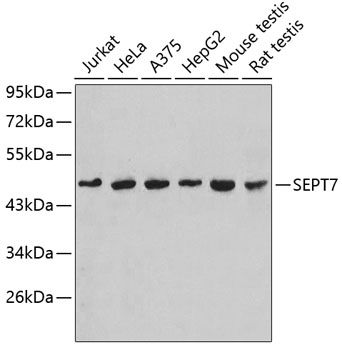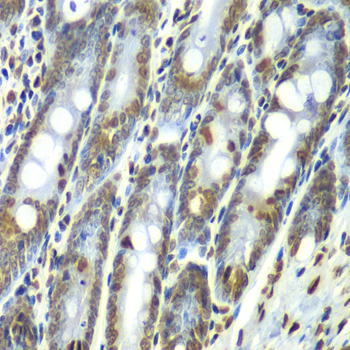Anti-SEPT7 Antibody (CAB3781)
- SKU:
- CAB3781
- Product type:
- Antibody
- Reactivity:
- Human
- Mouse
- Rat
- Host Species:
- Rabbit
- Isotype:
- IgG
- Research Area:
- Cell Cycle
Frequently bought together:
Description
| Antibody Name: | Anti-SEPT7 Antibody |
| Antibody SKU: | CAB3781 |
| Antibody Size: | 20uL, 50uL, 100uL |
| Application: | WB IHC IF |
| Reactivity: | Human, Mouse, Rat |
| Host Species: | Rabbit |
| Immunogen: | Recombinant fusion protein containing a sequence corresponding to amino acids 307-436 of human SEPT7 (NP_001011553.2). |
| Application: | WB IHC IF |
| Recommended Dilution: | WB 1:1000 - 1:2000 IHC 1:50 - 1:200 IF 1:50 - 1:100 |
| Reactivity: | Human, Mouse, Rat |
| Positive Samples: | Jurkat, HeLa, A375, HepG2, Mouse testis, Rat testis |
| Immunogen: | Recombinant fusion protein containing a sequence corresponding to amino acids 307-436 of human SEPT7 (NP_001011553.2). |
| Purification Method: | Affinity purification |
| Storage Buffer: | Store at -20°C. Avoid freeze / thaw cycles. Buffer: PBS with 0.02% sodium azide, 50% glycerol, pH7.3. |
| Isotype: | IgG |
| Sequence: | NYRS RKLA AVTY NGVD NNKN KGQL TKSP LAQM EEER REHV AKMK KMEM EMEQ VFEM KVKE KVQK LKDS EAEL QRRH EQMK KNLE AQHK ELEE KRRQ FEDE KANW EAQQ RILE QQNS SRTL EKNK KKGK IF |
| Gene ID: | 989 |
| Uniprot: | Q16181 |
| Cellular Location: | Chromosome, Cleavage furrow, Cytoplasm, Midbody, centromere, cilium axoneme, cytoskeleton, kinetochore, spindle |
| Calculated MW: | 50kDa |
| Observed MW: | 51kDa |
| Synonyms: | SEPT7, CDC10, CDC3, NBLA02942, SEPT7A, septin-7 |
| Background: | This gene encodes a protein that is highly similar to the CDC10 protein of Saccharomyces cerevisiae. The protein also shares similarity with Diff 6 of Drosophila and with H5 of mouse. Each of these similar proteins, including the yeast CDC10, contains a GTP-binding motif. The yeast CDC10 protein is a structural component of the 10 nm filament which lies inside the cytoplasmic membrane and is essential for cytokinesis. This human protein functions in gliomagenesis and in the suppression of glioma cell growth, and it is required for the association of centromere-associated protein E with the kinetochore. Alternative splicing results in multiple transcript variants. Several related pseudogenes have been identified on chromosomes 5, 7, 9, 10, 11, 14, 17 and 19. |
| UniProt Protein Function: | SEPT7: Filament-forming cytoskeletal GTPase. Required for normal organization of the actin cytoskeleton. Required for normal progress through mitosis. Involved in cytokinesis. Required for normal association of CENPE with the kinetochore. Plays a role in ciliogenesis and collective cell movements. Belongs to the septin family. 2 isoforms of the human protein are produced by alternative splicing. |
| UniProt Protein Details: | Protein type:Cell cycle regulation; Hydrolase; Cytoskeletal Chromosomal Location of Human Ortholog: 7p14.2 Cellular Component: cell cortex; actin cytoskeleton; microtubule cytoskeleton; cytoplasm; apical plasma membrane; nucleolus; stress fiber; plasma membrane; spindle; synapse; midbody; axoneme; nerve terminal; nucleus; cleavage furrow Molecular Function:identical protein binding; protein binding; GTP binding; structural molecule activity Biological Process: mitosis; protein heterooligomerization; cytokinesis; shape changes of embryonic cells |
| NCBI Summary: | This gene encodes a protein that is highly similar to the CDC10 protein of Saccharomyces cerevisiae. The protein also shares similarity with Diff 6 of Drosophila and with H5 of mouse. Each of these similar proteins, including the yeast CDC10, contains a GTP-binding motif. The yeast CDC10 protein is a structural component of the 10 nm filament which lies inside the cytoplasmic membrane and is essential for cytokinesis. This human protein functions in gliomagenesis and in the suppression of glioma cell growth, and it is required for the association of centromere-associated protein E with the kinetochore. Alternative splicing results in multiple transcript variants. Several related pseudogenes have been identified on chromosomes 5, 7, 9, 10, 11, 14, 17 and 19. [provided by RefSeq, Jul 2011] |
| UniProt Code: | Q16181 |
| NCBI GenInfo Identifier: | 67472677 |
| NCBI Gene ID: | 989 |
| NCBI Accession: | Q16181.2 |
| UniProt Secondary Accession: | Q16181,Q52M76, Q6NX50, |
| UniProt Related Accession: | Q16181 |
| Molecular Weight: | 437 |
| NCBI Full Name: | Septin-7 |
| NCBI Synonym Full Names: | septin 7 |
| NCBI Official Symbol: | SEPT7 |
| NCBI Official Synonym Symbols: | CDC3; CDC10; SEPT7A; NBLA02942 |
| NCBI Protein Information: | septin-7; septin 7 variant 4; CDC10 protein homolog; CDC10 (cell division cycle 10, S. cerevisiae, homolog) |
| UniProt Protein Name: | Septin-7 |
| UniProt Synonym Protein Names: | CDC10 protein homolog |
| UniProt Gene Name: | SEPT7 |
| UniProt Entry Name: | SEPT7_HUMAN |








